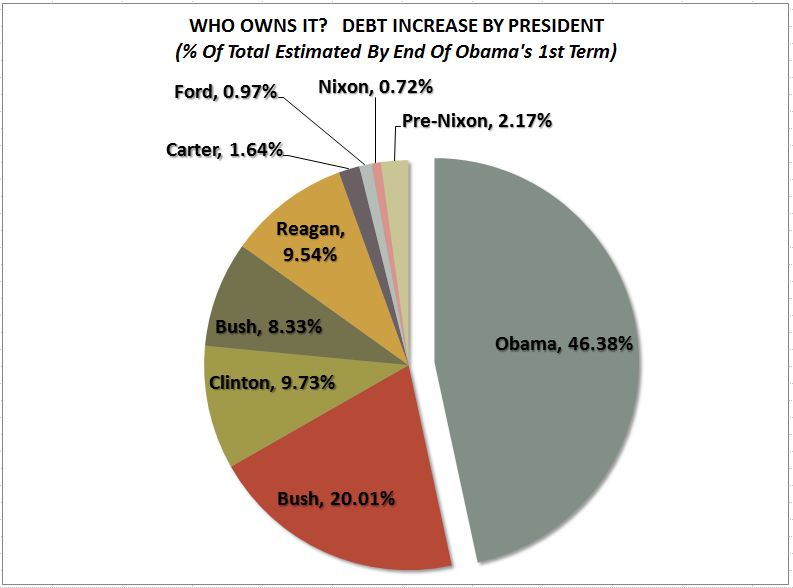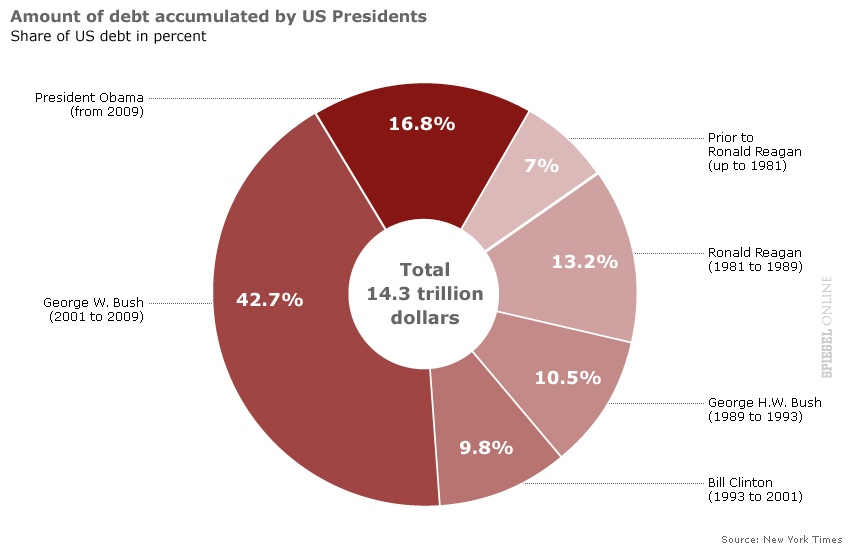Over at DShort (and SA), Lance Roberts had a commentary about the Presidential budgets we discussed this past weekend (US Debt Accumulation by President). As did many commenters on the original post, he took issue with the numbers assembled by Spiegel (sourced from the NYT).
Unfortunately, some people seem to be repeating a significant error in assembling this data. It reflects a common misunderstanding of how Presidents execute the Federal budget. Blame the Fiscal Year versus the calendar year for the misunderstanding.
The data was assembled in the original post is not by each President’s first day in office to his last, but rather, by the budgets each President submits to Congress that gets passed. (Congress may change the budget, but rarely appropriates more than what the President requests). I cannot imagine that any fair-minded person would look at this data any other way: The debt each President creates is a function of the budgets each President submits to congress. It is not based upon the literal time they spend in office. Therefore the only objective way to view the data is BY EACH PRESIDENTS BUDGET.
This is not an insignificant point. So, rather than indulge in irrelevant measures that mislead the reader, let’s go to the actual fiscal numbers of each President’s budgets to see what there is to see.
On January 20th, 2001, George W. Bush was sworn into office – but the budget for most of the rest of that year was Bill Clinton’s, passed by the prior Congress. Barack Obama was sworn in on January 20th, 2009 – but the budget for most of that year was that of George W. Bush. Why are these so? Because the Federal government’s fiscal year runs from October 1 (of the previous calendar year) to September 30. Hence, the FY 2001 is Clinton’s and FY 2002 is Bush’s. FY2009 is Bush’s, FY 2010 is Obama’s.
The actual budgets of the Presidents and their deficits — that’s what this is about, right? — are as follows:
George W. Bush is sworn in on January 20th, but his first budget does not take effect until October 1, 2001:
10/1/2001: Bush starting deficit – $5.8 trillion
9/30/2009: Bush ending deficit – $11.9 trillion
Bush debt contribution: $6.1 trillion
Barack H. Obama is sworn in on January 20th, but his first budget does not take effect until October 1, 2009:
10/1/2009: Obama starting deficit – $11.9 trillion
9/30/2011: Obama ending deficit – $14.8 trillion
Obama debt contribution: $2.9 trillion
Of the $14.8 trillion in total debt as of September 30, 2011, the Bush budgets generated $6.1 trillion in deficits versus the $2.9 trillion of Obama deficits. That’s 41.2% vs 19.6% by a reasonable methodology of measuring presidential debt.
These are the actual Presidential Budget deficits — not time in office, which is simply an irrelevant measure that no fair minded, mathematically literate person would use. (Thank you to my readers who schooled me in the details of the federal government’s Fiscal Year).
A few other details worth noting:
First, these are nominal numbers, not inflation adjusted. So as time goes on, each previous presidents’ numbers appear to be smaller. (As true for Nixon as it is for Clinton). Feel free to inflation adjust them yourselves.
Second, every president’s share of the deficit goes down once they leave office. As their successors’ add more debt to the total, it makes the predecessor Presidents’ share smaller. Happened with Reagan, is happening with Bush, will happen with Obama.
Third, Obama’s share of the deficit will (obviously) go up over the next few years. An offsetting factor is he inherited an economy in recession (dated to December 2007) and a stock market in collapse.
Fourth, Bush’s total percentage of deficit creation will go down (see item #2). His mitigating factors: He inherited a dotcom collapse; And we cannot hold him responsible for the recession that started a month after he was sworn in. On the other hand, he did inherit a surplus, and made it a policy objective to get rid of that surplus. (Mission accomplished)
All data sourced from Treasury: Debt to the Penny (Daily History Search Application)
The charts below show how that simple change — from each President’s actual submitted budget versus their official term in office — change the outcome of this analysis.
US Debt Accumulation by President: Based on time each President is in office (Erroneous Calendar Year)
>




What's been said:
Discussions found on the web: